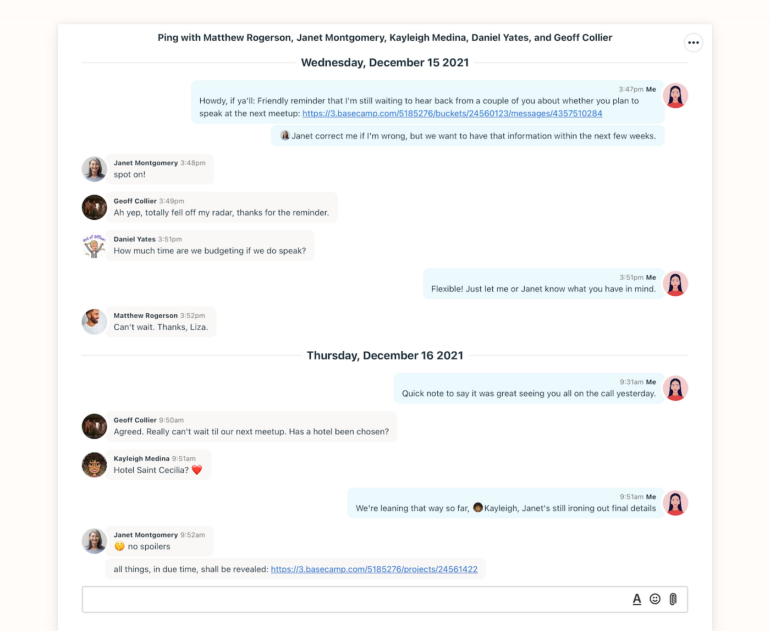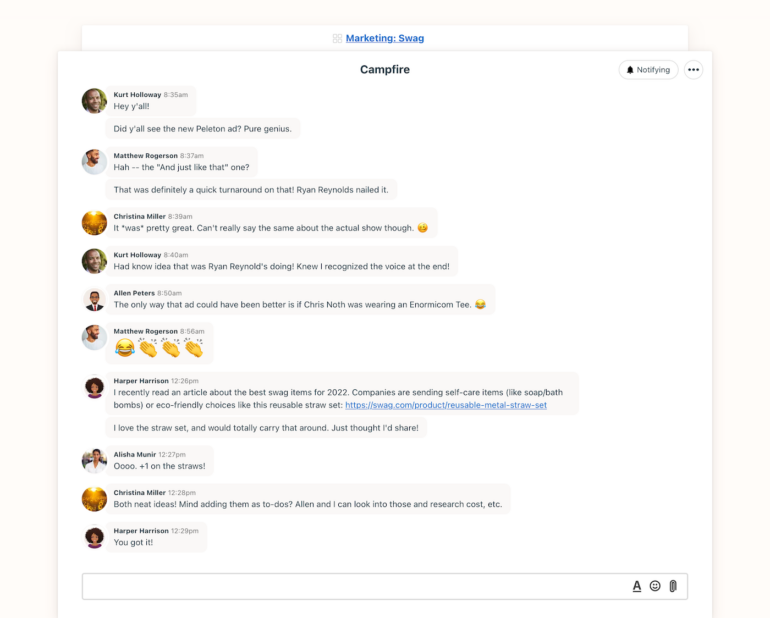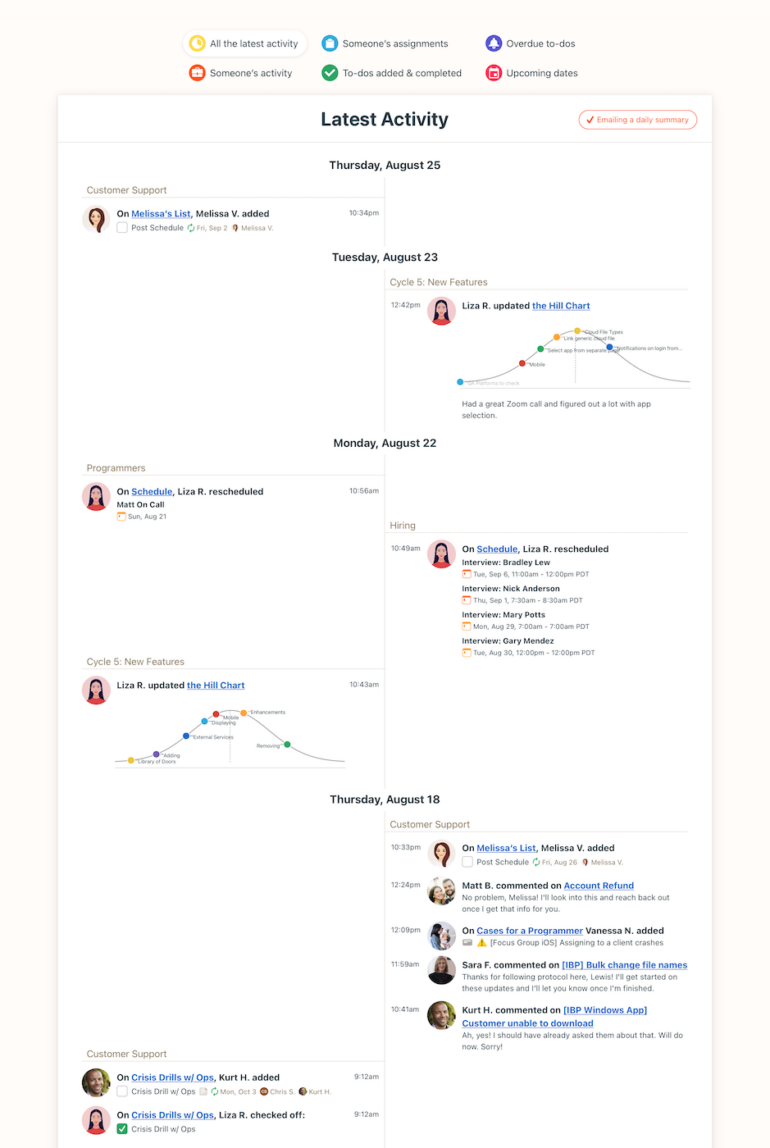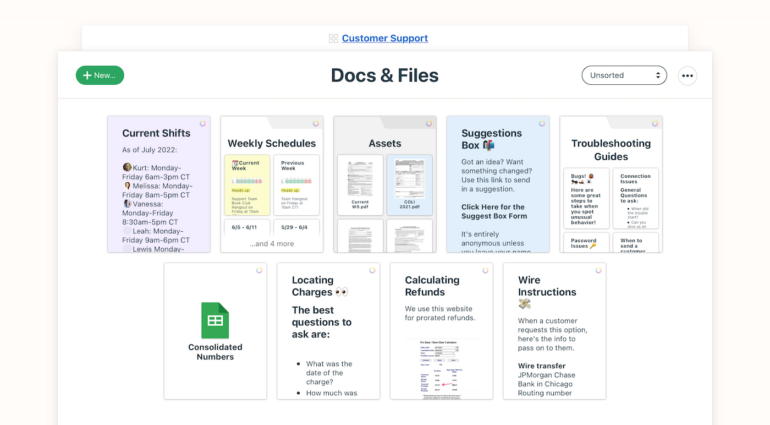Pricing, alternatives, pros & cons
Basecamp’s fast factsPricing: Basecamp paid plans start at $15 per user per month. Standout features:
Sign up for Basecamp’s 30-day free trial to see if it’s a good fit for your team. |
Launched in 2004 by 37signals, Basecamp is a collaboration and project management platform developed for freelancers, small teams, startups and distributed teams. It is suitable for tracking projects’ progress, storing and sharing relevant documents, and communicating with the project team. The solution helps improve project clarity, facilitates communication among team members and automatically updates team members on their tasks’ to-do statuses.
The best project management tool for your organization depends on your needs and preferences. If Basecamp is not the best fit for your team, we welcome you to explore other Basecamp alternatives or check our list of the top project management tools.
SEE: We also reviewed the best project management software for small businesses.
Jump to:
Featured project management software
Basecamp’s pricing
Unlike most project management tools that charge per user, Basecamp is quite flexible, giving users the option to select either the per-user plan or per-organization plan. Basecamp offers a free trial plus two paid plans. It also offers 10% off for nonprofits and charities.
Free trial
Organizations and individuals looking for a new project management tool can test-drive Basecamp for 30 days to learn if the solution is the best option for their use cases. Users can sign up for either the Basecamp per-user pricing free trial or the Pro Unlimited free trial, which is a fixed-price plan.
Prospective customers can register for Basecamp’s free trial in less than a minute by providing three basic pieces of information: name, email and organization name.
Basecamp
The Basecamp plan is best for freelancers, startups and small teams, costing $15 per user per month. It is a month-to-month plan, and organizations are charged based on the number of employee users on their team.
Most project management tools limit certain features to higher-tier plan types. Our research found that users can access all Basecamp features with this plan. This plan also includes 500GB of storage for files and documents.
Basecamp Pro Unlimited
Unlike the Basecamp plan, the Basecamp Pro Unlimited plan has no per-user charge. It has a fixed price of $299 per month when billed annually and $349 per month when billed monthly; again, these price points are for the entire organization rather than per user.
This plan is suitable for growing businesses and large teams. Aside from project management features, this plan includes priority support, one-on-one onboarding for new Basecamp customers and five terabytes of storage.
Key features of Basecamp
One thing that makes Basecamp unique is how it personalizes its product components. As such, Basecamp’s feature names may read differently from what you are familiar with in a project management tool, but the overall ideas and functionality are the same.
Hill Charts
Basecamp’s Hill Charts feature is a 10,000-foot visual representation of project progress. With Hill Charts, project managers can monitor all projects in their pipeline, as well as time to completion.
Each project is represented as a dot on the Hill Chart; users can drag the dot where they want it to be on the graph. The chart has two sides:
- Figuring Things Out (Uphill): This is the project planning stage, where teams brainstorm the best approach for handling their projects.
- Making It Happen (Downhill): Projects on this side of Hill Charts are at the execution stage.
Every update can be annotated, eliminating the need for daily standups.
Ping and Campfire chats
Ping is Basecamp’s version of one-on-one direct messages. It allows users to privately message or ping one person or multiple people and get responses in real time.

Users can also search their conversation history to find previous messages. Messages can be text-based, or users can add sound, videos and emojis – they can also attach files, quotes and code samples to the messages.

Basecamp’s Campfire is a real-time group chat where users can interact with all team members, ask general questions and call out members with @mentions.
Latest Activity

The Latest Activity feature offers a real-time feed of all activity — happening across all teams and projects — in one place. It enables team members to see current tasks, the assignee, their progress, their work status, what’s overdue and what’s on their plate at any given time. Those who can’t keep up with the activity dashboard can subscribe to a daily summary that sends activity updates to their emails.
Customization
Basecamp allows users to customize their project area to suit their needs. Companies can add their logos at the top of the tool, and users can pin or reorder their tasks the way they want. Recently and frequently viewed tasks automatically appear below the pinned cards for easy access. Users can also switch between card and list view and search projects using filter or command prompts.
Team members can customize their homepage to appear however they like. This feature gives flexibility to those who like to switch things up at will.
Track progress with to-dos
With Basecamp, users can create a list of tasks or subtasks, set due dates and then assign them to team members. From there, they can set reminders to receive notifications when tasks are completed or overdue. Team members can also add notes and file attachments to their to-do lists.
Documents and file storage

Teams that create lots of documents will find this feature beneficial. Users can drag and drop files to upload and add documents and images for storage. They can also reorder and color-code files for easy identification, search file version history and share files with team members.
Basecamp integrations
Basecamp has 75 integrations across nine categories, at the time of this writing. Categories include mobile and desktop apps; time tracking, invoicing and accounting; reporting, charts and planning; file backup and synchronization; software development; marketing, design and asset management; customer service and support; contracts and proposals; and developer-only tools.
Examples of Basecamp integrations include the following:
- Very Cloudy: With Basecamp Very Cloudy, users can share files from more than 10 third-party services, including Figma, Airtable, Adobe, Dropbox, Google, Box, OneDrive and more.
- Slickplan: Basecamp integrates with Slickplan, which provides reporting, charts and planning tools to help development teams plan, build, collaborate and share design mockups, content plans and sitemaps.
- Clockify: Although Basecamp lacks native time tracking capabilities, it integrates with tools like Clockify, making it easy for teams to clock in remotely.
- Pro Backup: With the Pro Backup integration, users can get daily automated backups and file synchronization for their Basecamp account.
Pros and cons
| Pros | Cons |
|---|---|
|
|
Alternatives to Basecamp
If Basecamp isn’t ideal for your business requirements, check out these alternatives.
| Feature | Basecamp | Airtable | Teamwork | Jira |
|---|---|---|---|---|
| Integrations | Yes | Yes | Yes | Yes |
| Task management | Yes | Yes | Yes | Yes |
| Native time tracking | Requires third-party integration | Requires third-party integration | Yes | Yes |
| Gantt charts | Requires third-party integration | Yes | Yes | Yes |
| Collaboration tools | Yes | Yes | Yes | Yes |
| Free plan | No | Yes | Yes | Yes |
| Starting price (billed monthly) | $15 per user per month | $12 per seat per month | $8.99 per user per month | $7.75 per user per month |
Airtable

Airtable is a low-code alternative to Basecamp. It was founded in 2012 by Howie Liu, Andrew Ofstad and Emmett Nicholas. Airtable allows users to visualize projects and tasks in different views, such as grids, kanban boards, Gantt charts and calendar views. Airtable includes many ready-to-use templates, which shorten users’ learning curves. Unlike Basecamp, Airtable offers a free plan for business use.
SEE: For more information, check out our full Airtable review.
Teamwork

Teamwork is a noteworthy alternative to Basecamp due to its advanced project management capabilities. For instance, Basecamp lacks Gantt chart views, time tracking and resource management features, whereas Teamwork offers all of these things.
Teamwork’s resource management helps project leaders plan and allocate resources efficiently in order to ensure projects are completed on time and within budget. With time tracking, managers can track contractors, freelancers and distributed employees’ work hours; this is beneficial for companies that pay per hour or project. Teamwork is ideal for distributed teams and agencies.
SEE: For more information, check out our full Teamwork review.
Jira

Jira is an issue-tracking software solution developed by Atlassian. It promotes Agile project management and has sprint planning and backlog management features. Jira serves as a central hub for software releases, bug fixes and feature implementation.
SEE: For more information, check out our full Jira review.
Who is Basecamp best for?
The best project management tool for a company depends on its needs and preferences. Our research indicates that Basecamp is best for small teams, startups, freelancers and remote teams that need a centralized location to communicate and collaborate on assignments.
Basecamp is also suitable for teachers and students because it’s free for them. Additionally, nonprofits can get up to a 10% discount when they buy this tool.
How we evaluated Basecamp
Our review methodology included gathering data from the Basecamp website, looking through Basecamp’s documentation, and evaluating product reviews from research and review companies like G2 and Capterra. We also analyzed user reviews of Basecamp to learn about its strengths, as well as areas for improvement based on customers’ complaints.
If you’re still not sure if Basecamp is right for you after this review, check out our list of the best cloud-based project management software.
Source: News
